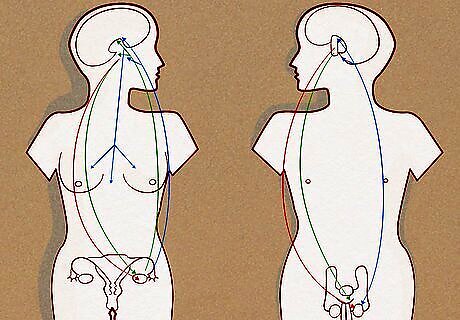
views
Understanding Sex Education Programs

Familiarize yourself with your local sex education requirements. Every school, state, province, or country will have its own set of requirements on how sex education can be taught. In most cases, if you are a professional educator, you will most likely be required to follow a certain curriculum provided for you. For example: In the United States, the U.S, Department of Health & Human Service identifies 28 evidence-based curriculums that are eligible to be taught. Your school or program may provide you materials and information from these curriculums. The Public Health Agency of Canada provides Canadian Guidelines for Sexual Health Education. It is a guide that provides specific curricula and teaching strategies to teach sex education. Canadian sex education teaches key concepts like health, health promotion, health education, sexuality, sexual health, and sexual rights. In the United Kingdom, sex education is compulsory after age 11, and focuses on teaching children about reproduction, sexuality, and sexual health. Sex and relationship education (SRE) is part of the national curriculum and is based on the Personal, Social, and Health Education (PSHE) framework of knowledge. Guidelines can be found on the UK government website.

Make sure teaching sex education is possible in your situation. In some countries, cultures, religions, and schools, sex education for children is not compulsory or mandatory. In these situations, teaching sex education to children can be difficult for many reasons. For example, sex education might not be welcomed and you may run into roadblocks before you are allowed to teach it. Before teaching sex education, you may have to: Speak to local officials about implementing sex education in your area. This might mean speaking to schools, your community, or members of your government. Prepare resources and evidence that sex education is needed. Join an organization or group that advocates for the implementation of sex education for the community. Plan your own sex education curriculum. You may be able to teach sex education but there are little resources available to you that provide tested and reputable sex education programs that can be taught in your area. In these cases, you may need to do extensive research, talk to sexual health professionals, and collaborate with institutions to come up with an effective sex education program.

Understand the different approaches to sex education. In North America, most curriculums advocate the need for comprehensive sexual health education, where multiple topics are discussed and taught extensively. Issues taught include contraception, gender, sexuality, abstinence, abortion, sexually transmitted diseases, and much more. Comprehensive sex education is correlated with lower rates of teen pregnancies, and slightly lower rates of teens reporting having vaginal sex. Some other approaches include: Family life education: This program places emphasis on preparing children for family life and reproduction. Population education: This program focuses on the sociological, environmental and economic consequences of population growth. Medical/disease education: This program emphasizes on avoiding disease and provides medical information about sexual health. Fear-based approach: This program emphasizes the risks of sexually transmitted infections, diseases, and HIV. Abstinence-based education: This programs focuses on abstinence from sex a way to avoid pregnancy and does not provide much coverage on how to use contraceptives, how to have safe sex, and how STIs/HIV work. Research shows that it is not effective at preventing sex or teen pregnancies, and areas with abstinence-based education have higher teen birth rates. Sexuality education: This approach places more emphasis on the individual, sexual activity, sexology, biology and behaviour. It presents sexuality as a key part of life and includes the message that sexuality and sex can be pleasurable.

Plan your own lessons or curriculum. Some sex education programs may already have detailed lesson plans for you to follow and some may only provide you with guidelines and will require you to come up with your own lessons. In the case that you will need to plan your own lessons, it is best to follow the established and accurate curriculums for sex education at your school, community, or sex health care provider. These programs have been tested for effectiveness and will provide helpful advice, approaches, and strategies to aid you in teaching sex education. Reach out to other educators who have already implemented or taught sex education. Ask them what was effective, what didn't work, and how they approached sex education with their learners. You may need to establish your own curriculum if you are teaching groups that need special attention, such as learners who have mental disabilities, LGBTQ+ learners, or if you are teaching in a community with specific beliefs and religious views.
Preparing to Teach Sex Education

Educate yourself on sex and sexual health. To better prepare yourself to answer any questions a learner might ask, it's important you understand the material you will be teaching. You can go online, to your local library, or bookstore to find information about sex, sexual health, and sexuality. There are also many organizations that provide courses and materials to help educators teach sex education. Sex education is more than just teaching about sexual behaviours. This means you should also educate yourself on issues such as abstinence, body image, gender, sexuality, sexual development, sexually transmitted diseases, sexual health, and sexual pleasure. Use established, evaluated sex education sources and curriculums to aid in your research. There are many myths and misconceptions that surround sex education and sex in general. Knowing what the truth is and having accurate information about sex education can help you teach better and prevent you from relaying inaccurate or negative information to your learners. Educating yourself about sex can help increase your comfort level with talking about sex or certain topics related to it to others. People think sex and relationships are something they should be able to manage on their own. They should have all the knowledge and information about it. But in reality, they do not have any information or training in this matter or have no sex education. Few people may have a little reproduction education which is quite straightforward. But most people do not know the art of maintaining a quality love life with their beloved for years. Another thing in our society is that people do not get any positive training and education about sexuality. Instead, there is a lot of negative stuff. Shame, fear, and guilt are associated with sexuality.

Understand who you are educating. Age is an important factor that will shape how you educate sex to your learners. Some parents, guardians, and educators will be uncomfortable with sex being taught to children as young as kindergarten. But using age-appropriate information to teach sex education can help ease worries and discomforts about teaching such a sensitive topic like sex. Different issues or topics will be taught depending on a learner's age. Established curriculums will have versions that are tailored to the age of the learner. Knowing the stage of sexual development of your learners will aid you in answering questions and help you provide age-appropriate information and resources for your learners. This way, you can avoid situations where you overstep boundaries or teach beyond what is appropriate to your learners.

Determine what your goals are when teaching sex education. Defining your goals or what you would like your learners to achieve after you teach is a helpful way to organize and teach your lessons. In general, most sex educators strive for these goals: To reduce negative outcomes from sexual behaviours, such as unwanted or unplanned pregnancies and infection from sexually transmitted diseases. To provide appropriate knowledge and skills for learners to make healthy decisions about their sex life and future. To build self-confidence in learners. To help learners develop positive relationships and experiences with their sexuality. To provide medically accurate information about concepts like abstinence, contraception, and other health concerns. To respect community, social, and individual values and beliefs regarding sex.

Provide a safe environment when talking about sex. If you are a teacher or someone who works for the community or a sexual health organization, you will most likely be teaching in a classroom setting. Whether you're a teacher, parent, guardian, or a friend, it's important you set up a safe environment to talk about sex. A safe environment: Allows learners to feel positive and confident as they learn and ask questions. Is free of negative judgments. Discourages censorship and instead, promotes an open and honest environment. Can be in a classroom, at a community centre, or at home.

Prepare to tackle complex issues like gender and sexuality. Gender, sex, and sexuality are different concepts that are often confused together. By differentiating them, you can help ease a learner's confusion about their identity, especially for those who are struggling with "non-normative" identities. These identities include people who may have gender identity issues like trans youth or those who may be questioning their sexuality. Reach out to the community to obtain a better understanding of these complex issues. There are many organizations within the LGBTQ+ community that can provide you with materials, resources, and even curriculums for you to follow. Advocate for safer policies regarding issues like homophobia or transphobia. Trans and LGBTQ+ youth are more likely to be harassed and abused verbally, physically and sexually. By educating or approaching the community with these issues, you help save lives of LGTBQ+ individuals and foster a more accepting environment. Partner with professionals that specialize in certain topics to ensure your curriculum covers everything accurately and effectively. For example, you may ask invite a member of the LGBTQ+ community to lead a lesson and talk about their experiences and share their knowledge about sexual health and well-being to your learners. Make sure your curriculum is age-appropriate, culturally sensitive, and respectful of the beliefs and values of differing groups. This may be difficult to do, but it's not impossible. By getting feedback from other educators, professionals, and parents or guardians of learners, you can help ensure your curriculum is appropriate.

Practice talking about sexual health. This can be very beneficial if you find the topic of sex education uncomfortable to discuss. Try talking casually and openly to a peer or a close friend about sexual health. Or practice teaching your lesson to someone you're close with. This exercise can help you with become comfortable talking about sex and also provide you with feedback on how effective your teaching is. Practicing can help you avoid mistakes like being overly critical of someone else's opinion about sex, laughing in times of discomfort or embarrassment, and avoid lecturing or talking down to people when you're teaching.

Contact your learners' parents or guardians with information about the content you'll be teaching. While teaching young learners, it's extremely important you keep parents and guardians involved in the process of sex education. Send parents and guardians a letter detailing the sexual health program you will be teaching to their children. This way, learners can choose to either opt out of the lesson or provide you with comments before you start teaching. Many sexual health organizations and curriculums can provide educators with a sample letter to use to send to parents and guardians. You can send simple outlines of each lesson or a detailed summary of the whole program. If you are teaching adult learners, it is also important to let them know what you plan to teach. Some learners may have differing beliefs and values and may choose to opt out of certain lessons or from the entire program you'll be teaching.
Teaching Infants and Young Children

Remind yourself that sex education for babies is not about acts of sex. The thought of teaching sex education for infants can be daunting and taboo, but most parents, guardians, and caregivers already teach infants sex education without even knowing it. From age 0 to 3, children will begin to explore their bodies, learn the differences between cisgender males and females, and start to form their own gender identities. Sex education for infants takes the form of teaching children about their bodies and helping them form healthy relationships and bonds with caregivers. If you are teaching infants about their sexual health, you are most likely their parent, guardian, or primary caregiver. Most institutions do acknowledge the importance of sex education for infants, but it is unlikely there are any formal educational programs out there for children that young. By making the conscious effort to teach infants about their bodies, about genders, and by promoting good relationships, you are creating a positive foundation for their future sexual well-being.

Teach children the correct names of body parts, including their genitalia. Children start to learn body parts as infants and are often told to show caregivers their nose, eyes, and ears, for example. At this time, infants should also be taught the correct names of their genitalia. By teaching children early, they will become comfortable and familiar with their bodies and be more aware of sexual or reproductive health problems as they age and will be more likely to seek help. Use opportunities like bath time or diaper changes to teach infants about their bodies. It can be as simple as pointing to a child's genitals and saying, "That is your penis" or "That is your vulva". You can also start to make associations between sex and genitalia by saying, "Most females have vaginas" and "Most males have penises." This teaches facts, while also opening the door for helping your child understand and respect transgender classmates, friends, or family members.

Tell children about the basic rules of privacy. Many children will develop curiosity about the body as young as 2 years old. They may start engaging in behaviours such as asking each other about their bodies, peeking at each other's bodies in bathrooms, or even showing private body parts to each other. Young children may also start to hug, kiss, and touch each other. At this point, it is important to talk to children about the basic rules of privacy, such as: Your body is your own. Children should learn that their body belongs to them and no one can touch it without their permission. They should be taught how to say "no" to kissing, hugging, and other types of physical contact they don't want, whether it is appropriate or not. Good touch versus bad touch. Children should be taught how to recognize appropriate and inappropriate touching. A good way to teach this is to use The Underwear Rule. This means touching anywhere that is covered by underwear is inappropriate. They should also be taught to consult with a trusted adult or family member when bad touches happen. Good secrets and bad secrets. Teaching children that there are bad secrets and good secrets helps prevent sexual abusers from manipulating children into keeping secrets like if they are being touched inappropriately or being abused.

Observe young children's gender expressions. By two, a child will begin to understand what gender is, and even identify their own gender identity. However, it is common for children to experiment with their gender identity through role playing and dressing up. It's important to be aware of your child's gender expression so you can prepare for certain situations: Some children may start to show signs of being transgender. Children may ask questions or make assumptions about what is correct behaviour for a certain gender. Talk to them about stereotypes, if needed, and assure them that it's okay to break stereotypes (like a boy playing with dolls or a girl getting dirty playing sports). Other people or children may disagree with a child's gender expression and cause the child distress. If so, help the child deal with the problem, and reassure them that it's okay to be themselves.

Teach the basics of reproduction. Children at this age will begin to ask questions about babies such as "Where did I come from?" or "Where do babies come from?" You can start to tell young children the basics of reproduction: Babies grow in one person's (almost always a woman's) uterus. You may use different language like, "You came from Mommy's belly" or "Mommy made you, and Daddy helped." Two people make babies. For example, "Mommy and Daddy made you, because we wanted to have a child." It is always recommended to use accurate and correct language to eliminate confusion in the future and allow children to be comfortable with talking about reproduction.
Teaching Elementary-Aged Children

Explain to children the process of puberty. Children as young as 8 may begin to experience puberty both physically and mentally. It is important to make children aware what changes may follow, such as: Physical changes like the growth of genitals, breast development and menstruation, and growth spurts. Sexual feelings that may lead to sexual attraction to others and masturbation. Emotional changes that affect how children see themselves, their self-image, and how they relate to others like their parents, family, and friends.

Anticipate that children will start to explore behaviours that may be sexual in nature. Elementary-aged children may start to become physically intimate with each other and start dating, kissing, or touching. Some older children may even begin to explore the idea of being sexually intimate with someone. Talk about the importance of permission when it comes to touching each other. If you see a child trying to force touch on someone else (e.g. trying to kiss an unwilling kid), scold them and say it's not appropriate. For example, "He said no! You need to listen to him." Some education programs will start to educate elementary-aged children about protection and contraceptives when engaging in sex. As well as the effects of HIVs/AIDs and STIs/STDs. The continuation of teaching children that their bodies are their own will help them engage in safe and healthy relationships with others.

Acknowledge children's struggles with body image, social skills, and sexuality. At this time, children will come across difficulties with expressing themselves, or have trouble understanding what is happening to them as puberty begins. It's important to address issues such as: Sexuality. Since children at this age will start to develop attraction towards one another, some may experience difficulty adjusting to their sexuality, especially if they identify as gay, lesbian, bisexual, asexual, or anything other than what is assumed as "normal". Provide resources and comfort to help children adjust to their sexuality. Gender identity. Some children may be expressing their gender differently or identify as transgender. Validate these differences by providing children tools and resources to better navigate their gender, and also protect them from discrimination or bullying. Masturbation. In most sex education programs, masturbation is seen as a healthy and normal activity. Many may have questions about masturbation or about their sudden development of intense sexual feelings that might have lead to incidents like having "wet dreams". Family life. Family life may be affected since parents or family members may start to give more responsibilities to older children and even divide tasks based on gender. At this time, sex or gender discrimination is an important topic to cover. Body image. With all the physical changes happening, it's important to address healthy ways to deal with low self-esteem or issues with body image.
Teaching Older Children

Emphasize the importance of consent when engaging in sexual activities. Some children from 15 to 19 years old will be sexually active so it is important to talk about what consent is, what it looks like, and stress the importance of it. Teaching consent will decrease the likelihood of sexual violence and also promote healthier relationships and better overall sexual health. An overview of consent includes knowing that: Consent is a voluntary and enthusiastic "yes". It is not based on silence, previous sexual activities, or what the person is wearing. Consent needs to be asked and given freely. Both parties should ask each other if they would be willing to engage in a certain sexual activity and both parties should answer. Consent is not coercion. Pressuring someone into sex, threatening them, intimidating them, blackmailing then, or guilt-tripping them into sexual acts are all forms of coercion.

Teach children how to use protection and contraceptives. Depending on your program or curriculum, you may need to teach children how to use protection or about contraception. You may need to provide them with demonstrations, resources, and discuss the benefits and effects of using protection and contraceptives. Be sure to talk about the wide variety of contraceptives available. For example, condoms can be used by both females and males. Teach children the effects of having unprotected sex. These include having an unwanted or unplanned pregnancy, and receiving and transmitting diseases.
Using Different Teaching Strategies

Learn the teaching strategies required of your program. If you are following a specific program or curriculum, it is most likely you will be given teaching strategies to learn and use. In most cases, these strategies were tested, researched, and judged as the best way to teach a certain sex education program. Some curriculums will be very specific, providing you with detailed lesson plans, activities, and strategies. Many educators will work with their school, community, or sexual health organization to figure out what the best approaches and strategies to teaching sex education are. If there are particular strategies or approaches that you believe are effective, you can always find a way to become involved with how sex education is taught to others. Join organizations, your school board, or speak to officials about ways to better sex education in your area.

Choose activities that encourage students to work cooperatively. Most sexual health organizations encourage educators to adopt cooperative learning strategies. This means students or learners work with others in assignments, discussions, and projects. This gets students involved in their learning and helps them construct meaning from information on their own. Some examples of cooperative learning strategies include: Inquiry-based learning: This approach places students' questions, ideas, and observations in the centre of their learning experience. You will act as a "provocateur" or someone that introduces students to ideas or topics that is of interest to them or what matters to them. Students are guided to investigate and look for answers using critical thinking skills, problem-solving skills, and evidence-based reasoning. Problem-based learning: This approach begins by presenting a problem to students before they receive any knowledge about a topic. This method gives you more control of what topics or problems to focus on. After students are informed of the problem, they are encouraged to seek knowledge and solutions cooperatively together. For example, you could make up a hypothetical problem like "Sally doesn't want to have sex with her boyfriend. How can she tell her boyfriend this?" and then ask students to come up with a solution. Project-based learning: This approach has students working on a long term project that addresses and investigates complex questions, problems, or challenges in sex education. A popular project-based learning approach used in sex education is to simulate what having a baby is like. Students bring home a lifelike baby doll that cries, eats, poops, and pees, and are asked to care for it for an extended period of time. The project helps students realize that caring for a child can be difficult and teaches them responsibility. If you have had a baby, try caring for the doll yourself, and then tell them how it compares to caring for a real baby. (Is it easier? Harder?)

Use visuals and media to aid your teaching. You can use pictures, diagrams, videos, or visual demonstrations to keep students engaged while you're teaching. Try these activities: Fill in the blank diagrams. This is especially helpful to demonstrate the human body and things related to it such as the menstrual cycle, genitalia, areas affected by puberty, or the reproduction cycle. Watch informative videos. In most sex education curriculums, videos will be provided to help you teach your students. Demonstrate how to do things. In many sex education courses, educators will demonstrate with objects how to put on a condom, how to use a menstrual pad or tampon, how contraceptives work, and how sexually transmitted diseases work. It's important these demonstrations only simulate the actual action. You may have seen educators put condoms on bananas or use small cups of water to demonstrate how a tampon works.

Encourage students to reflect through journal writing. Journal-writing encourages students to record, reflect, and write about their health learning. Many health care providers encourage people of all ages and life stages to use journal writing to keep track of their health concerns. Having a health care journal can: Keep track of your health. It's easier to detect patterns if you record any concerns you have about your health the moment it happens. A constant ache or pain could indicate a bigger problem if it has been happening for days or weeks. An injury in the past might explain a new health concern today. Keep track of medications. A journal could help remind you to take medication, get tested regularly, or inform them of what medications they have used in the past. Provide an overall review of a person's health. Just by recording all things health-related, a health care journal can give a brief summary of your health.

Evaluate and assess your students' learning. After teaching your students, it's important to evaluate how effective your teaching was. There are many ways you can assess your students: Do a comprehension check. You can simply ask students to reiterate what they learned after a lesson. Or give them a quiz or do a review exercise. Observe your students. You may notice a few disengaged students, or you may realize a certain topic makes everyone feel uncomfortable. By observing your students, you can assess how effective your lesson was. Assess projects and assignments according to a rubric. This is a more accurate way to measure the success of your lesson. Many curriculums provided by your school or a health care organization will have rubrics to help you assess students' learning.
Managing Your Learners While Teaching

Establish the ground rules before starting the lesson. Rules help create a safe and open discussion during your lesson. Tell your learners to: Listen and speak appropriately during your lesson. This might mean raising their hand, speaking only when called, and using appropriate language when talking. Respect other students. Some students may be reluctant to share information or ask questions that might sound "silly" to others. Respecting each other means being non-judgmental towards one another. Maintain confidentiality during the lesson. Personal experiences and information might be shared during the lesson and students should be told not to share these stories or information to others outside of the class.

Inform students that you will respect their privacy. Let your students know that you are here to discuss facts and opinions about sexual health—not to expose or push students to talk about their own or any sexual experiences or lack thereof. Refrain from talking about your own sexual experiences if it doesn't enrich or benefit the lesson and your learners. In some situations, especially if you have a very close or casual relationship with your learners, sharing stories and experiences can help relax students and even open them up to express their own opinions and questions. However, it's best to avoid this unless you have a very good and mutual understanding with your learners. In some situations, sharing explicit personal information about yourself can make learners feel uncomfortable.

Actively promote critical thinking and open-mindedness. A great educator is not only someone who is able to relay information to their learners, but is also one who is able to listen and inspire their learners. There are many ways you can encourage your students: Refrain from taking a one-sided point of view on an issue. Instead, express an open attitude and willingness to listen and discuss any and all issues relating to sexual health. Show that you value a learner's opinion or what they have to say. Use validating responses or phrases like, "That's an interesting comment you've made" or "I think what you said is very important" or "I understand your concern". Ask for your learners' opinions on an issue. After explaining an issue or concept, open the discussion by asking if anyone has questions, concerns, or comments they'd like to make. Ask what they think about what you've just taught them. Be flexible when teaching your lesson. Sometimes learners will have burning questions that they can't keep until the end to ask. Encourage and allow students to ask questions or make comments whenever they arise, even if they might steer the discussion towards an unintended topic in your lesson plan. However, always use judgement: not every question is worth answering right then and there.

Relate with your learners what they have learned in the past. Every learner will enter a sex education course or classroom with different ideas on how sex or sexual health works. A good way to ease into the beginning of a lesson is to ask your students to share what they know about a certain topic. This activity encourages students to actively participate in discussions. Knowing what the students already know can help give you an idea how to go about the lesson. You will have a better sense of what issues to focus more on and any misinformation you will need to correct.

Allow learners to ask questions anonymously or privately with you. In any setting, there will be learners who are shy or feel uncomfortable asking their questions in front of a large group. Give opportunities to these learners by: Providing resources to them. Direct students to reputable resources where they can find their own answers to their questions such as websites, books, or information from sexual health organizations. Giving them a point of contact to discuss their concerns with their own sexual health. It can be a guidance counsellor, a sexual health professional or service, or even you. Let learners submit questions anonymously. A helpful activity to try in class is to have all your students write down their questions or concerns on a piece of paper and submit it to your anonymously. You can then answer these questions in front of the class, or incorporate the questions in a future lesson.
Responding to Questions

Reinforce what is an appropriate or inappropriate question. Although you should encourage students to openly ask questions, you should also evaluate which questions are appropriate to answer and which are just asked to produce a reaction rather than to enhance learning. Tell your students: "If I don't answer a question, it's not because it's a bad question. It might be that I feel it isn't an interest to all students." "If you ask a question and I don't answer it, ask me again after class in private."

Validate students' concerns. Even if you don't answer a question or come across an opinion or question you can't respond to, you can validate the student's comment. Some helpful ways to respond to students' comments is to: Give affirmation: "Thanks for asking", "That is a great question!", or "Please tell me more about what you'd like to know." Ask for clarification positively: "Sounds like you have a real concern. Can you please tell me more about what's on your mind?" or "That sounds like an important question. Could you explain it to me a bit more?" Address feelings: Some questions may be loaded with feelings such as embarrassment or disgust. Try prefacing your answer by saying, "We are all embarrassed sometimes, but it's important to discuss it". Normalize the question: "Many people ask that question!" or "That's something a lot of people have wondered about" but never use the word "normal". Normal is not a proper term to use as it has a heavy social meaning to it rather than a medical meaning. In one setting or culture, something "normal" might be "abnormal" in another.

Answer questions as honestly and as best you can. If there is a question you don't know the answer to, let your students know. At the same time, validate their questions or concerns to let them know you understand them and will be working hard to answer their question eventually. If a question makes you uncomfortable, let your students know. You might not be able to control your reaction or feelings toward a question and letting your students know how you feel about a question can help clarify why you can't answer a question. Try saying, "I'm a bit uncomfortable with this question" and follow up with validation.

Determine if you will be answering questions about personal behaviour. Students might ask questions about their own personal behaviours that you may or may not want to discuss with the class. You might be asked questions like, "Is it normal to...?" or "Did you... when you were growing up?" These questions might be religious or culturally loaded and may question morals rather than the facts you are teaching. Deal with these questions by: Reinforcing the ground rules. If you choose not to answer personal behaviour questions, tell students, "We won't be discussing personal behaviour questions during this class." Referring students to other resources. Other sexual health care professionals, parents, guardians, or religious organizations may be better equipped at answering questions about morals surrounding sexual health. Speak to them privately about their concern. A question about a personal behaviour might be better understood in context. You might find out a student's family is religious after they ask you if abortions are okay. You might then refer them to the appropriate person to speak to about such an issue.

Diffuse questions asked to "shock" others. Some students may ask questions to shock others into a reaction. They might have a real concern but are too embarrassed to address it seriously, or they feel the need to divert attention away from the topic being discussed. Never assume these questions are silly or tell students that their question is silly. Instead, remind students of your ground rules and try to guide this question into a teachable topic. Reword any slang vocabulary to diffuse the question. A student might ask, "Why do balls hurt when they're hit?" You could respond by saying, "First, the proper term for balls is testicles. Testicles are very sensitive and do hurt when they're hit" and proceed to answer their question. Students may also criticize certain topics and say statements like, "Guys only want sex from girls!" You can respond by addressing the underlying concern in a question or statement. In this example, you can respond by saying, "It seems like you are concerned about respect in relationships."
Teaching in Conservative Communities

Follow the policies provided to you by the community. Each institution, community, and country will have different policies that dictate how sex education can be taught. These policies might come from the community or they could come from larger bodies of governance. In some cases, a conservative community will have certain views on how sex should be talked about and taught. However, that does not necessarily mean that is how sex education should be taught. And instead, the education system may have differing views and policies on how to teach certain sexual health topics. Discuss with community leaders, educators, and organizations on what sex education looks like in a conservative community. They may have advice or provide you with guidelines on how to communicate with learners and their families, and even how to manage controversy and criticism about sex education. Remember, the goal of sex education is promote sexual health to learners. Do what is best for your learners, but practice judgement.

Prepare to respond to people who oppose sex education. People who oppose to sex education are not limited to conservative communities. The first thing to do if you come across someone who opposes sex education is to listen to their point of view and their reasoning. Do not belittle them or antagonize them by telling them they are misinformed or lack knowledge. Instead, respond to their concerns calmly and be as helpful as you can. There are many reasons why someone might oppose to sex education: They lack knowledge about your program, and don't know how you will implement sex education. Give them information about your program, the lessons you will be teaching, and your goals while teaching. If a whole community is opposed to sex education because of this reason, bring written material about your program to community meetings, to community members, and discuss your program with them. They fear they sex education will distress or corrupt young people. Let them know that sex education advocates for responsible sexual health and does not always primarily focus on sexual activities or behaviours. They believe talking about sex leads to sexual activity. There are many reputable and authoritative studies that show sex education does not increase sexual experimentation. Instead, sex education only changes the way sex is performed, usually meaning people who have had sex education are more likely to use contraceptives and get tested for STIs. Explain that your intent is to lower the rates of teen pregnancy, and that you'll be using research-approved methods to do this. Sex education opposes their moral, religious, or cultural beliefs. Let them know that it is perfectly okay to opt out of sex education. Or let them know when certain topics will be discussed and allow the option to opt out of classes that go against a certain belief.


















Comments
0 comment